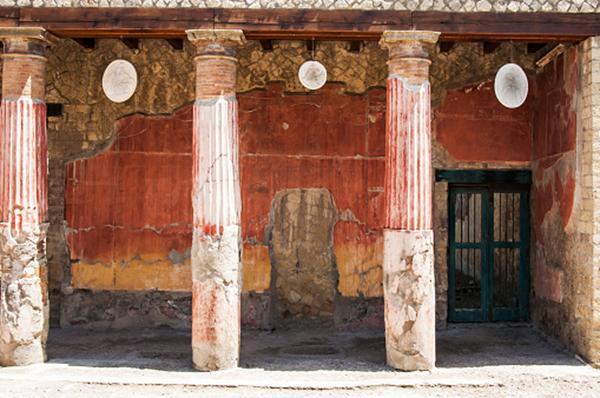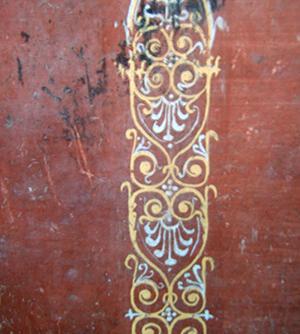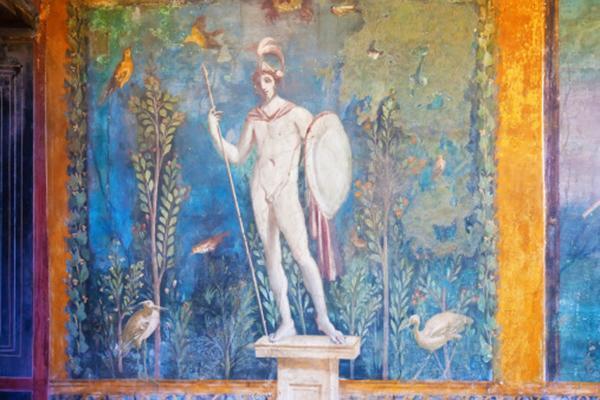Wall paintings: the encaust technique
Post from EditorialsThe murals, by Roman times were made with the technique of encaust, a mixture of colors and hot wax applied to the surface
Wall paintings: the ancient technique of encaustic
Encaustic is the painting technique (a rather complex execution) known for many thousands of years, which substantially gives you the way to perform the painting on the support, usually a wall, but also wood or even ivory, with color pigments formed from wax dissolved in liquid or an emulsion of wax mixed with water.
The technique was certainly widespread during the Roman times, and because widely described by Vitruvius and Pliny the Elder in their works, which mainly attested by various exhibits (including for example some famous portraits on wood from the Fayyum and dated between the I and the V century AD) and iconographic evidence.
In addition, many archaeologists and art historians have long debated the precise technical execution of the murals of Pompei and Herculaneum, assuming the encaust.
In the Renaissance, a variation of this technique was used instead, unfortunately with little luck, by Leonardo da Vinci to decorate the Salone dei Cinquecento in the Palazzo Vecchio in Florence, with the famous Battle of Anghiari: the painting, known thanks to some copies dated sixteenth century performed on the basis of the still visible remains, because of the defects of execution was subsequently destroyed (or coated with other frescoes) and currently it is considered lost.
Ancient techniques for an encaust painting
The execution of a wall decoration with real encaust is very complex and requires a lot of experience and skill. 
In fact, according to the descriptions left by Vitruvius, on a plaster performed in a workmanlike manner and above all perfectly polished, one proceeded applying Punic wax melted by the fire and mixed with a little oil.
Later, after a few days of the execution of the painting one needed to warm the surface with a warmer full of embers, or metal plates and hot irons with the dual aim to penetrate the wax in the support and smooth the surface.
This was the most delicate stage of the proceeding, because an excessive heat would have poured the wax, ruining irretrievably the painting, while a heat too low or unevenly distributed would not give the surface its typical glossiness.
Once cooled the support, it is then passed to the final polish with a clean cloth.
The Punic wax was obtained by boiling several times the virgin wax bee in sea water with the addition of Nitrum (a compound of sodium carbonate, sodium hydroxide and potassium hydroxide); while the powder pigments were probably the same as other painting techniques.
However, the practical application of this system is quite difficult, both for the high danger posed by the use of very hot tools, and for the remarkable array of equipment needed:
bowls or trays resistant to fire or heat (in ancient terracotta or metal, and currently also glass pyrex) and a means to generate heat, such as a space heater or a camping or workshop stove, or formerly small fires, warmers and braziers.
Alternatively to what described above, to minimize risks and difficulties one can still proceed in two other ways:
- fell back on a recipe of easier execution
- Opt for the simple protection of a wall painting performed by another method (for example the fresco or lime paint) with the addition of a layer of liquid wax.
This last process, called encausticatura, is obviously distinct from the real encaust. With this system most likely were finished the murals of Pompeii.
With this system most likely were finished the murals of Pompeii.
Chemical analyzes of samples of decorated plaster have indeed found traces of wax in the composition of the colors, which instead was used just as protective paint, needed to make the decoration extremely smooth, polished and shiny.
According to other hypotheses, these decorations were instead first performed applying the fresco background colors, and then defining the details (including, for example, the edges of the carpet in the picture on the left) encaustic.
The contemporary system to create murals with encaust
An encaust perform system considerably simpler and actualized to the contemporary needs is the following:
1) First, you must get the appropriate pigments for fresco, the excellent floor wax contains beeswax, mineral spirits or turpentine, paint brushes of various sizes, bowls (defined by color), cotton cloth, soft wipes a hair dryer (possibly provided with extension cable if the electrical outlets are too far away) to generate the necessary heat.
2) preparing colors by mixing pigments in powder form for fresco with some water, the floor wax and a small amount of turpentine or turpentine: the right density of each color is similar to that of tempera used for the painting on canvas, but the dough should not be too liquid, to avoid unpleasant sagging.
It is preferable to mix the components in this sequence: pigment powder, water, floor wax and then turpentine or mineral spirits. However, to find the most suitable dosage, it is advisable to do some preliminary test on a hidden portion of the substrate to be decorated.
3) At this point, you can do the painting, if necessary by mixing the colors to shades in between. Once finished, the surface should be left to rest for a couple of days, so that the wax can coagulate properly.
4) subsequently, the floor wax is poured into a bowl, without the addition of any pigment or more ingredient, and brushed on the entire surface, making sure that the writing is well uniform and of not generating sagging. For better quality of the finished work it is advisable to apply a second coat of wax.
5) Once finished, you have to make the wax penetrate in the layer of plaster, uniformly heating the surface with the hair dryer.
6) Once cooled, it is then the turn of the final polishing, to be performed in two phases: first with a cotton cloth (to avoid leaving unsightly tissue fibers), and the next day with a softer cloth.
7) the final effect will be a painting with a very smooth and shiny, satin like and almost translucent surface.
79163 REGISTERED USERS










